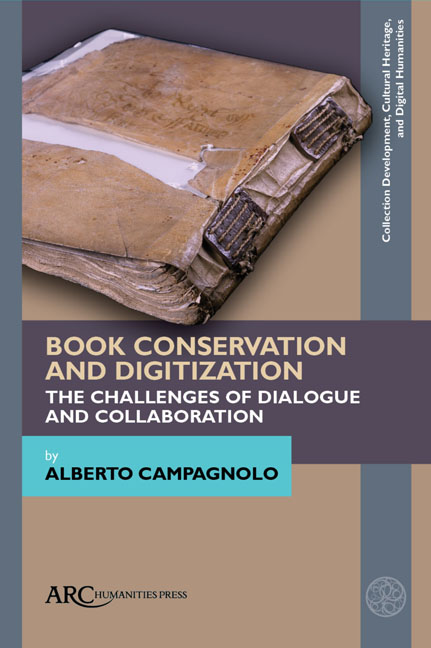Chapter 2 - Conservation and Digitization: A Difficult Balance?
Published online by Cambridge University Press: 20 November 2020
Summary
HISTORICAL BOOKS HELD in memory institutions are likely to undergo conservation treatments that could alter, or even destroy, material evidence, to preserve their function as content-delivering tools. For this reason, bookbinders— formerly, aside from amateurs, the sole practitioners of restoration and conservation treatments in the past— are mentioned alongside fire, water, neglect, collectors (and servants and children!) in the well-known nineteenth-century book by William Blades, The Enemies of Books.
I will now place on record some of the cruelties perpetrated upon books by the ignorance or carelessness of binders. […] Indeed, so conservative is a good binding […] that many a worthless book has had an honored old age, simply out of respect to its outward aspect; and many a real treasure has come to a degraded end and premature death through the unsightliness of its outward case and the irreparable damage done to it in binding.
Blades laments, in particular, the destruction of old bindings by the hand of careless bookbinders, for “everything which diminishes the interest of a book is inimical to its preservation, and in fact is its enemy.” Then, in an unusually illuminated judgment for his times, he stresses how “old covers, whether boards or paper, should always be retained if in any state approaching decency.” This has also the great advantage of not depriving the future generations “of the opportunity of seeing for themselves exactly in what dress the book buyers of four centuries ago received their volumes.”
At the core of the destruction of old bindings and the damaging of old books (also through the application, mostly for aesthetic reasons, of bleach and other harsh chemicals) lies the focus on making them usable and the ignorance of the history of each volume. In essence, this is equal to the incapability of putting each material element of the object in relation to the context, history, and significance of the book as a whole, in an effort to interpret the data and reveal the meaning of each object, as emphasized in the model offered in the previous chapter.
- Type
- Chapter
- Information
- Book Conservation and DigitizationThe Challenges of Dialogue and Collaboration, pp. 49 - 82Publisher: Amsterdam University PressPrint publication year: 2020



